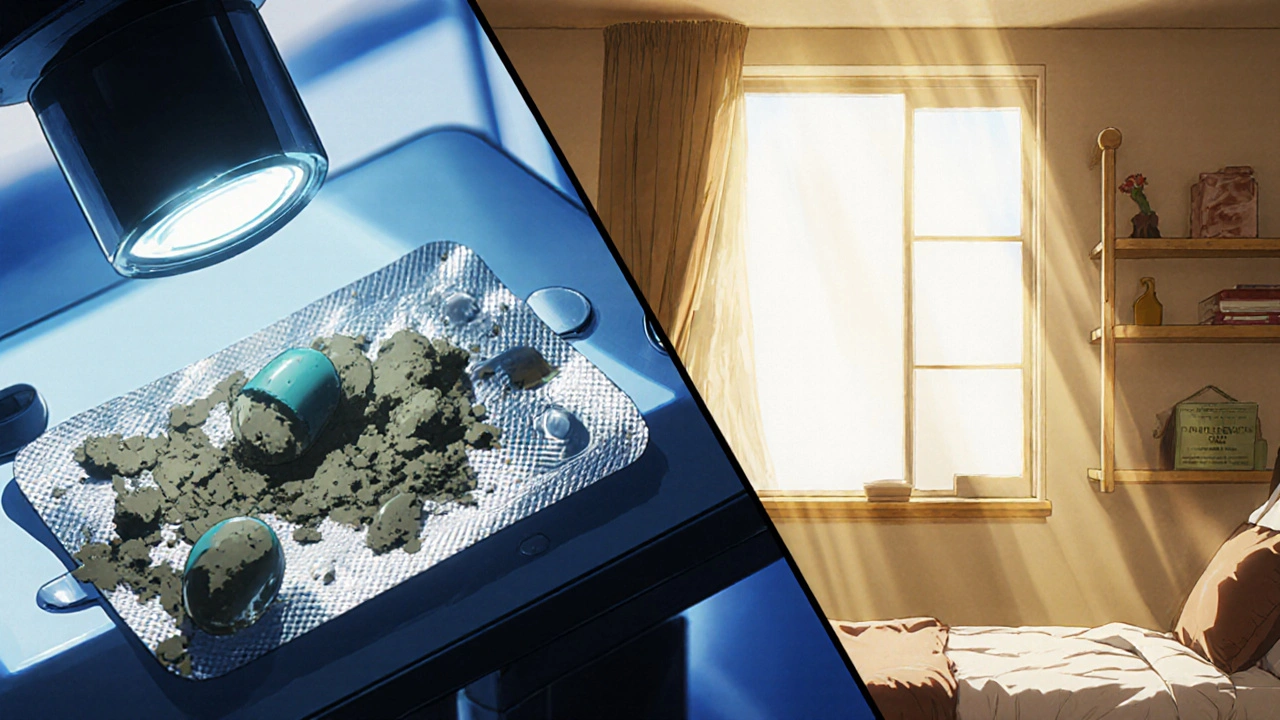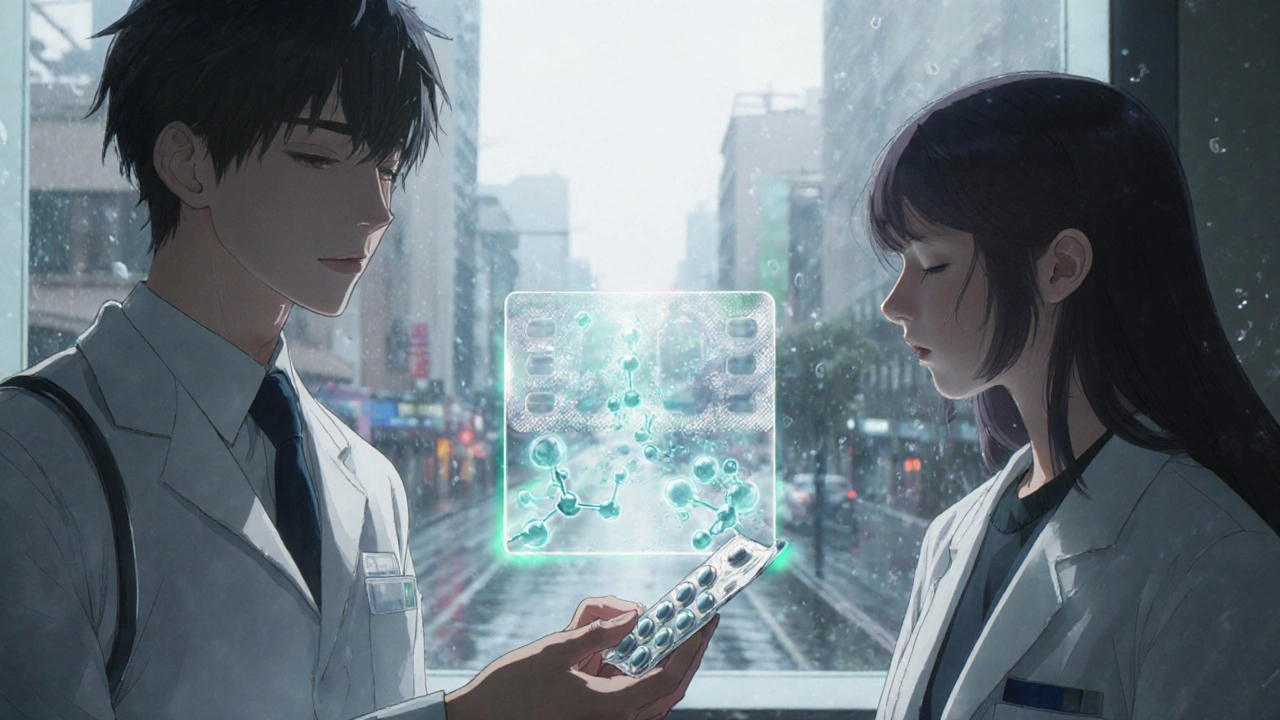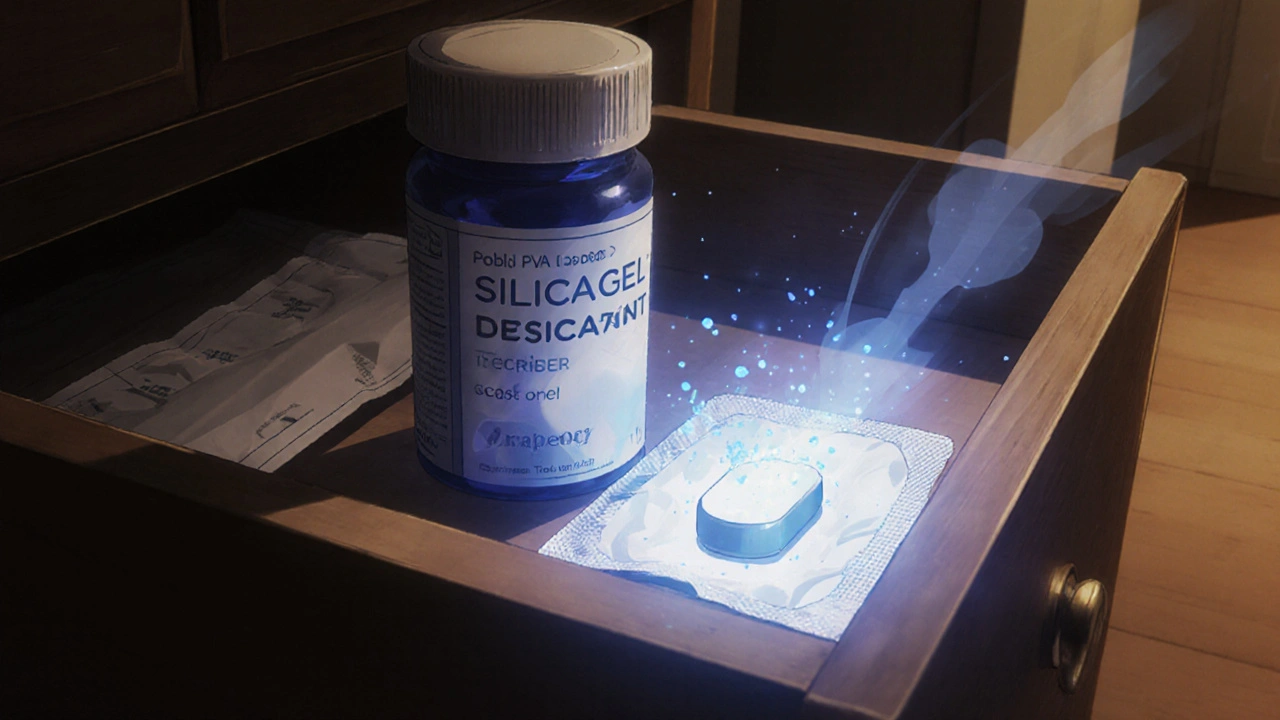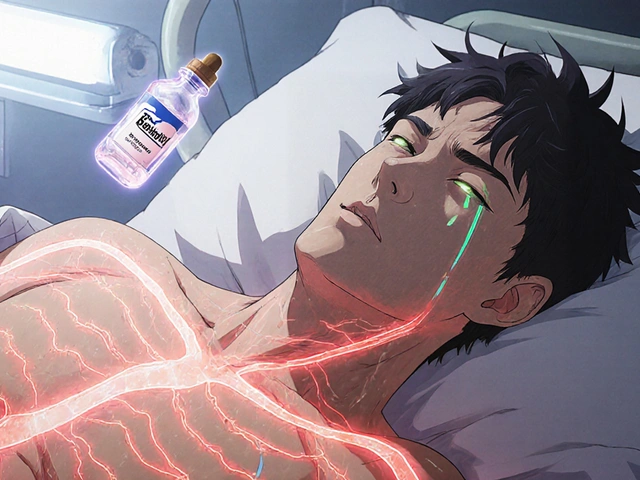Moisture doesn’t just ruin your phone or your favorite pair of sneakers-it can also ruin your pills and capsules. If your medicine has been sitting in a bathroom cabinet, a hot car, or a plastic bottle without a desiccant, it might not work anymore. Worse, it could make you sick. In humid climates like Sydney, where humidity regularly hits 70% or higher, moisture damage to medications is a real and underreported problem. Studies show that moisture damage is behind nearly two-thirds of medication quality failures in the U.S., leading to reduced effectiveness, harmful breakdown products, and even recalls.
Why Moisture Destroys Pills and Capsules
Pills and capsules aren’t just sugar and powder. They contain active ingredients that are often chemically unstable when exposed to water vapor. Even small amounts of moisture can trigger hydrolysis-a chemical reaction where water breaks down the drug molecule. Aspirin, for example, turns into salicylic acid and acetic acid (vinegar) when it gets damp. That’s why old aspirin sometimes smells like vinegar. The result? You’re not getting the medicine you paid for. You’re getting something weaker, or worse, something irritating. Other common drugs that fall apart in humidity include vitamin C, antibiotics like amoxicillin/clavulanate, and many psychiatric medications. The active ingredients in these pills are hygroscopic, meaning they actively pull moisture out of the air. Once that happens, the drug starts degrading. You won’t always see it. The pill might look fine. But lab tests show the potency can drop by 30% or more in just six months if stored poorly.The Three-Layer Defense System
The pharmaceutical industry doesn’t leave this to chance. They use three layers of protection, and you should too.- Film coating - This is the first line of defense. Many modern pills have a thin, invisible layer of polyvinyl alcohol (PVA) coating, like Opadry® amb II. Unlike older coatings made from hydroxypropyl methylcellulose (HPMC), PVA blocks moisture three times better. If your pill has a glossy, smooth finish, it’s likely PVA-coated. That’s good. If it looks chalky or dull, it might not be.
- Desiccants - These are the little packets you find in pill bottles labeled "Do Not Eat." They’re usually made of silica gel and can absorb up to 40% of their own weight in water. A properly sized desiccant can keep moisture levels in a 500-pill bottle from rising above 3.5% over two years-even in humid environments. The problem? Many manufacturers skip them or use undersized ones. If your bottle doesn’t have one, you’re on your own.
- Proper packaging - HDPE plastic bottles are common, but they’re not moisture-proof. They let vapor through. Aluminum blisters or foil-lined containers are far better. But even the best packaging fails if you leave the cap off for hours or transfer pills to a glass jar or pill organizer.
The most effective strategy? All three layers together. A PVA-coated tablet in a foil blister with a silica gel pack is the gold standard. But if you’re stuck with a plastic bottle, you can still protect your meds.
What You Can Do Right Now
You don’t need a pharmacy degree to keep your pills dry. Here’s how to act now:- Never store pills in the bathroom. That’s the worst place in your house. Showers create steam. Sinks leave condensation. Humidity there can hit 80% daily. Move them to a cool, dry closet or bedroom drawer.
- Keep the desiccant in the bottle. Don’t throw it out. Even if the bottle is half-empty, the desiccant is still working. Removing it lets moisture in every time you open the cap.
- Don’t transfer pills to pill organizers unless you have to. Most organizers are plastic and open to the air. If you use one, fill it weekly, not monthly. Keep the original bottle with the desiccant as your main storage.
- Check the expiration date. If your medicine is old and the bottle has been opened for more than a year, assume it’s losing potency. Don’t risk it.
- Buy from reputable pharmacies. Chains like CVS, Walgreens, or Australian pharmacies like Chemist Warehouse typically use better packaging than small clinics or overseas online sellers. Look for foil blisters or bottles with visible desiccants.

What Not to Do
Some common habits are dangerous:- Don’t refrigerate pills unless the label says to. Cold air holds less moisture, but when you take a cold bottle into a warm room, condensation forms on the outside-and drips inside. That’s worse than room temperature storage.
- Don’t use rice as a desiccant. Rice absorbs some moisture, but it’s slow, dirty, and can introduce bacteria. Silica gel is engineered for this. It’s clean, fast, and safe.
- Don’t ignore mold or discoloration. If your pills are spotted, sticky, or smell odd, throw them out. Even if they look okay, don’t take them. The FDA has issued recalls for pills that looked normal but had degraded into toxic compounds.
When to Ask Your Pharmacist
If you take multiple medications, especially in a humid climate, talk to your pharmacist. Ask:- "Is this medication moisture-sensitive?"
- "Does the bottle come with a desiccant?"
- "Can you switch me to a blister pack or a bottle with better packaging?"
Many pharmacists can request better packaging from manufacturers. Some even offer special moisture-resistant containers for high-risk medications like insulin pens or psychiatric drugs. Don’t assume they’ll offer it-ask.

The Bigger Picture: Why This Matters
Moisture damage isn’t just about wasted money. It’s about safety. A study in the Journal of Pharmaceutical Sciences found that patients who took degraded antibiotics were 40% more likely to develop resistant infections. People on blood pressure or diabetes meds who took weakened doses had more hospital visits. In tropical countries, up to 78% of pharmacists report patients skipping doses because they don’t trust their meds after seeing pills change color or texture.This isn’t a niche issue. It’s global. In places like Brazil, India, and Australia, humidity-driven degradation is a leading cause of medication failure. The solution isn’t high-tech. It’s simple: keep it dry. Keep it sealed. Keep the desiccant in.
What’s Next for Medication Protection
The industry is moving toward smarter solutions. New pill bottles now have tiny moisture sensors that change color if humidity gets too high. Some companies are testing biodegradable desiccants made from plant starches. Others are embedding moisture-absorbing materials directly into the pill coating.But for now, the best technology you have is awareness. You don’t need expensive gadgets. You don’t need to be a scientist. You just need to treat your pills like the life-saving tools they are-not like candy you leave on the counter.
Can I reuse desiccant packets from pill bottles?
No. Once a silica gel desiccant has absorbed moisture, it’s saturated and can’t work again. Some packets can be dried out in an oven, but that’s not safe or practical for home use. The risk of contamination or improper drying isn’t worth it. Always use new desiccants from a trusted source if you need extra protection.
Are all plastic pill bottles the same?
No. HDPE (high-density polyethylene) bottles are common but porous to water vapor. Bottles made from polypropylene (PP) or those with a moisture-barrier lining perform better. Look for bottles labeled "UV-resistant" or "moisture-barrier." If the bottle feels thick and opaque, it’s likely better than a thin, clear one. Foil blisters are the best option for long-term storage.
What if my pills are already damp?
If your pills are sticky, discolored, cracked, or smell strange, throw them away. Even if they look okay, moisture can cause invisible chemical changes. Don’t try to dry them out. You can’t restore potency. Taking degraded medication could be ineffective-or dangerous. Contact your pharmacist for a replacement.
Do liquid medications need moisture protection too?
Yes, but differently. Liquid medications like syrups or suspensions are less vulnerable to moisture because they’re already in solution. But they’re sensitive to heat and light. Always store them in a cool, dark place. Check expiration dates carefully-liquids often expire faster than pills. Never freeze them unless instructed.
How do I know if my pill has a moisture-resistant coating?
Look closely. PVA-coated pills usually have a shiny, smooth surface and don’t feel chalky. HPMC-coated pills look more matte and may feel slightly rough. The best way to know? Ask your pharmacist or check the manufacturer’s website. Brands like Pfizer, Novartis, and Teva often list coating types in their product information. If you’re unsure, assume it’s not protected and take extra steps to store it properly.





i swear the gov is putting moisture in our meds so we gotta buy new ones every 6 months... my aspirin always smells like vinegar now. not a coincidence. they know we dont check the desiccant.
also why do they use plastic? aluminum is cheaper. they dont care if you die.
This is exactly why I stopped trusting American pharmaceuticals. The Irish system at least uses foil blister packs as standard. You people let your meds sit in plastic like it's a grocery bag. Pathetic.
Let’s be real - the entire pharmaceutical-industrial complex is built on obsolescence. They design pills to degrade faster than your iPhone battery because it’s more profitable. PVA coating? That’s a marketing gimmick. The real solution is home compounding with anhydrous excipients. But no, you’d rather just keep buying more bottles from CVS while the desiccant packet languishes in your trash can like a forgotten love letter.
This was so helpful!! I always thought keeping meds in the bathroom was fine since it’s cool… now I’m moving everything to my bedroom drawer 😅 thank you for the clarity! Also - I’m saving the desiccant packets now. No more tossing them!
in india we dont even have this problem because our meds are made to survive 45c heat and 90% humidity. you guys are weak. if your pills go bad in a bathroom you deserve to be sick.
Honestly, this is one of those posts that makes you stop and think. I never realized how much I was risking by keeping my blood pressure meds in the medicine cabinet. I moved them to a sealed container in my closet today. Small change, but feels like a win.
The hydrolysis kinetics of hygroscopic APIs under non-isothermal conditions are grossly understudied in consumer literature. Most OTC packaging lacks ASTM D6653-compliant vapor transmission barriers. You need to demand Eudragit® EPO or HPMC-AS coatings - not just PVA. And please, stop using pill organizers. They’re molecularly porous.
I’m so glad someone finally broke this down without jargon. My mom takes 8 meds and she’s always worried hers look "off." I’m printing this out for her. You’re right - asking the pharmacist is the most powerful thing we can do. No shame in asking for better packaging.
I knew it. I knew the system was rigged. Desiccant packets are removed on purpose. They want you to think your meds are failing so you buy more. I’ve been collecting them for years. One day they’ll come for our water too.
You people are so naive. The FDA doesn’t require desiccants because they’re in bed with the plastic bottle manufacturers. I’ve seen the memos. It’s all about profit. Your aspirin smells like vinegar? That’s not degradation - that’s a chemical signature. They’re tagging your meds for surveillance.
my cousin in texas said her pills turned green after a heatwave. she took them anyway. now she's in a coma. i told her not to but she said 'it's just a pill.' now i keep mine in a safe with a dehumidifier. you're all gonna regret this.
I’ve worked in compounding pharmacy for 18 years. The truth is, most people don’t realize how fragile these molecules are. A pill isn’t a rock - it’s a living chemical system. Moisture doesn’t just reduce potency - it creates new compounds, some toxic. That’s why I always tell patients: if it looks, smells, or feels weird - it’s not worth the risk. Your body remembers what your brain forgets.
And yes - keep the desiccant. Even if it’s been open for a year, it’s still working. I’ve seen silica gel packets from 2019 still absorbing moisture in a half-empty bottle. They’re silent heroes.
In Mumbai, we store antiretrovirals in sealed containers with silica gel and temperature loggers. The WHO guidelines are clear - 25°C and <60% RH is the threshold. Why is this not standard in the US? It’s not a lack of knowledge - it’s a lack of will.